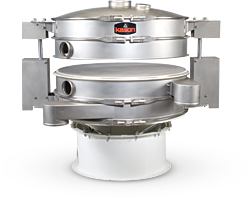Speeds cleaning, screen changes
 Kason's "Air-Lift" quick-access system for circular vibratory screeners allows rapid interior cleaning, inspection and screen changes while reducing manual effort.
Kason's "Air-Lift" quick-access system for circular vibratory screeners allows rapid interior cleaning, inspection and screen changes while reducing manual effort.
The device consists of two vertically mounted air cylinders that are located on opposing sides of any circular screener and affixed to mounting brackets on the lower and upper screening frames.
To operate, a quick-acting band clamp connecting the frames is removed and a remote air valve is actuated, raising the upper frame(s). The procedure is reversed to reconnect the frames.
One entire raise/lower cycle, including disconnection and reconnection of the frames, can reportedly be accomplished in five minutes, reducing downtime during inspection, cleaning and screen-changes. In addition, one operator can now perform what was previously a two-person task, depending on screen diameter.
Safety features include a safety lock-out that secures the frames in the open or closed position when the upper screener housing is raised or lowered, safety bars that prevent the housing from accidentally descending while in a fully-raised position during screen changes or wash down, and optional enclosures that cover the pneumatic cylinders (shown).
The Air-Lift device is available on any new Kason screener, and can be retrofit to any circular vibratory screener of any make or model from 40 in. to 84 in. (1000 mm to 2135 mm) in diameter, including screeners having single or multiple decks, and screens with or without center holes and/or anti-blinding devices.
Kason screeners equipped with the device are available in mild steel, or in stainless steel finished to 3-A, cGMP, USDA, FDA or industrial standards.
The screening assembly is suspended on springs that allow it to vibrate freely while minimizing power consumption and preventing vibration transmission to the floor. Beneath the assembly is an imbalanced-weight, gyratory motor that creates multi-plane inertial vibration for the purpose of controlling the flow path of material on screen surfaces and maximizing the rate at which material passes through the screen.

